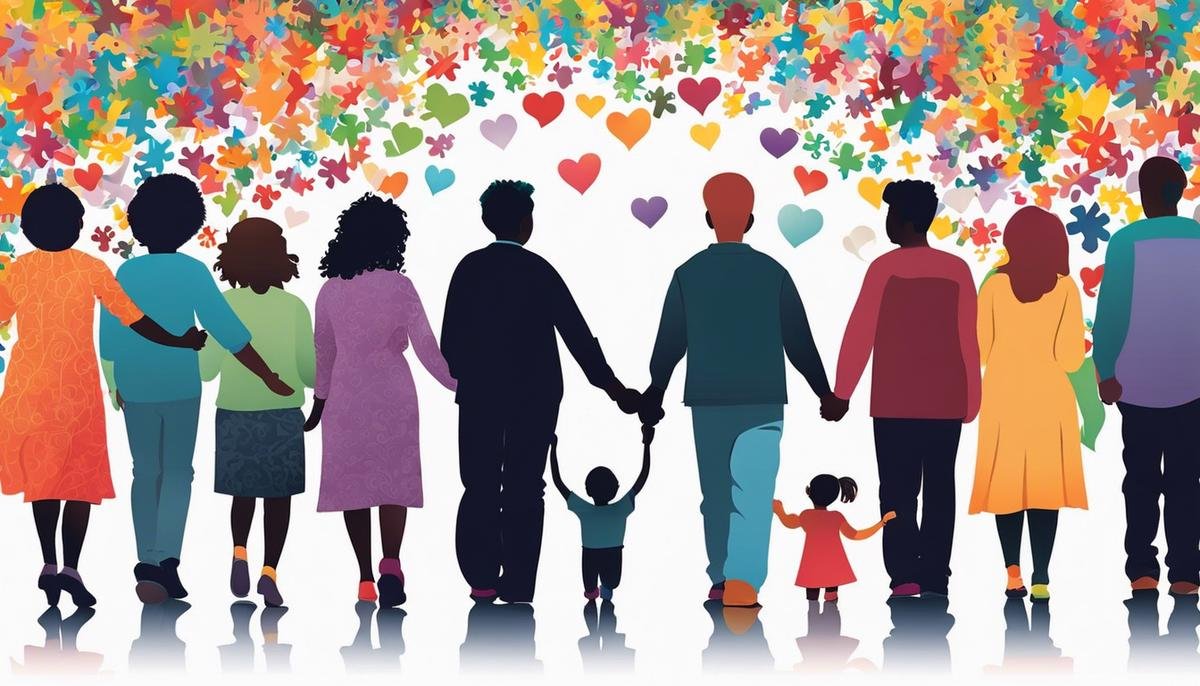
Autism, a neurodevelopmental disorder, is often misunderstood and overly simplified by stereotypes that fail to capture its complex nature. Its manifestation uniquely varies in every child, undergoing continuous changes as they grow. Many bear witness to the fact that autism is far from a one-size-fits-all condition. Yet, stereotypical views persist, painting all individuals on the spectrum with a broad brush. These misconceptions can lead to the marginalization of autistic children and their families, compromising their quality of life. As we further delve into this article, we seek to erode these damaging stereotypes, advocating for a greater understanding of the diverse realities of autism.
Understanding Autism
Understanding Autism and its Impact on Children
Embarking on a topic as complex as autism can feel daunting, yet it’s essential for promoting awareness, understanding, and growth in our communities. Let’s dive in together to uncover more about this condition that affects millions of children worldwide.
Autism, formally known as Autism Spectrum Disorder or ASD, is a group of complex neurodevelopmental disorders. These disorders are characterized by varying degrees of challenges in social interaction, communication, and repetitive behaviors. Every child with autism is unique, hence the term ‘spectrum’. This ‘spectrum’ reflects the range of symptoms and their severity, which can range from mild to severe.
It’s important to remember that ASD isn’t defined by a singular symptom but instead by the distinct pattern in which symptoms occur in individual children. Some common signs of ASD most generally appear by the age of 2-3 years. These can include:
- Difficulty engaging in social interactions
- Avoiding eye contact or physical touch
- Delayed, limited, or no speech
- Unusual or repetitive actions
- Difficulty adapting to changes in routine or environment
Let’s take a moment to address the elephant in the room. How does autism impact children and families? Living with autism can affect a child’s development, relationships, and way of learning.
Children with ASD often experience the world in an overwhelming manner as a result of sensory issues. Imagine an explosion of colors, sounds, and smells that you can’t switch off or ignore – that’s how some children with ASD might feel. As a result, they might withdraw from socializing or seem aloof, not out of indifference, but as a coping mechanism.
It’s also common for children on the spectrum to face challenges in speech and language comprehension. This can make expressing needs or articulating emotions a difficult task, but it does not equate to a lack of intelligence or ability.
Moreover, children with autism can demonstrate incredible passion and skill in a certain area of interest. From art to science to music, these concentrated interests provide a platform where their talents can genuinely shine.
On a family level, recognizing and adapting to a child’s autism diagnosis can bring its own unique journey. It might mean adjusting expectations for development, learning alternative communication methods, or assisting with sensory integration. But amidst these challenges, also lie opportunities – opportunities for boundless love, patience, understanding, strength, and resilience.
Navigating this journey isn’t always an easy task, but resources, support groups, and intervention therapies are available to help children and families cope and thrive. Remember, every child on the autism spectrum can grow, learn, and build on their strengths. A diagnosis isn’t defined by its limitations, but by the opportunities it presents for differently-abled living, learning, and loving.
While we’ve barely scratched the surface of understanding autism, we hope to have provided a friendly doorway into the conversation about this condition. The journey continues as we aim to foster communities of acceptance and inclusivity for every beautifully unique child. Autism doesn’t come with a manual, but it indeed comes with a community that’s wholeheartedly committed to understanding, acceptance, and support.

Common Stereotypes About Autism
Title: Dispelling Common Misunderstandings and Stereotypes About Autism
When it comes to discussing Autism Spectrum Disorder (ASD), it’s essential to be mindful of the misleading stereotypes and misconceptions often perpetuated. These preconceived notions, mostly rooted in lack of awareness or misinformation, can easily create barriers in understanding the true nature of ASD. This article aims to debunk some commonly held misconceptions and stereotypes about autism, paving the way for empathy, acceptance, and inclusivity.
Misconception 1: Autism is a Mental Illness
One of the most pervasive misunderstandings is that autism is a mental illness. In reality, ASD is a neurodevelopmental disorder affecting the nervous system. It’s essential to distinguish this difference because the support and approach for autistic children differ greatly from those with diagnosed mental conditions.
Misconception 2: People with Autism can’t Feel Emotions
Contrary to this notion, individuals with autism experience emotions just like anyone else. The difference lies in how they express and process them, which can often be overwhelming or confusing. Accepting the varied emotional expression of autistic children can provide crucial support for their emotional development.
Misconception 3: Autistic Individuals are All Savants
Savant skills, often displayed as extraordinary memory or artistic abilities, are present in a small subset of the autistic population. Perpetuating the view that every autistic person is a savant diminishes their wide range of skills, abilities, and unique personalities beyond these rare manifestations of genius.
Misconception 4: Autistic Children don’t Want to Socialize
While social interactions can be challenging for those with ASD due to sensory overload or difficulty understanding social cues, this doesn’t translate to a lack of desire to connect with others. Many autistic children enjoy companionship and thrive in a supportive, understanding social environment.
Misconception 5: Autism is Caused by Poor Parenting
Evidence-based science attributes autism to genetic and environmental factors, not parenting methods. This misguided stereotype unfairly stigmatizes parents, leading to unfounded blame and guilt. Parental support can significantly impact the development of autistic children by providing tailored care that meets their unique needs.
Misconception 6: Only Boys can have Autism
While autism tends to be more common in males, females can also be on the spectrum. Due to diagnostic biases and differences in presentation of symptoms, many girls and women with ASD may go undiagnosed or be diagnosed later in life.
By dispelling these harmful misconceptions and replacing them with fact-based, compassionate understanding, a more supportive and inclusive environment can be created for individuals with autism. Through education and outreach, everyone can play a significant role in challenging stereotypes and promoting acceptance in our families, schools, and broader communities.

Impacts of Stereotypes on Autistic Children and Their Families
Stereotypes and Their Impact on Autistic Children and Families
Stereotypes have a far-reaching effect when it comes to autistic children and their families. These preconceived notions can amplify stigmas, deflect our understanding, and discourage connection. Hopefully, by addressing a few of these stereotypes, we can inspire a shift in attitudes that fosters a more inclusive environment for our children to grow and thrive.
One common stereotype is that autism is synonymous with mental illness. While it’s true that autism is a neurological difference, categorizing it as a mental illness is a distortion. Autism is a spectrum disorder – it presents a range of traits that invariably affect communication, social interaction, and sensory processing. However, it’s not a defect or a disease, but a different way of experiencing and interacting with the world.
Ever heard the saying, “The eyes are the windows to the soul,” suggesting that emotions can be read in the eyes? While that may ring true for some, it can be misleading for autistic individuals. They certainly do not lack feelings; they simply express their feelings in ways that may deviate from the norm. Misinterpreting this difference as a lack of emotion is not only unfair but damaging, promoting a misconception that distances us from truly understanding them.
There’s also a sweeping misconception that all autistic individuals possess savant skills, such as the ability to perform complex mathematical calculations instantly or to memorize intricate details. These extraordinary abilities, though showcased in some individuals with autism, are not standard. Every autistic individual presents a unique blend of strengths and challenges. Assuming savant skills heightens the danger of undue expectations and potential disappointment, obscuring the unique characteristics each child possesses.
While some children with ASD struggle with social interactions, it’s certainly not due to a lack of interest. In fact, many autistic children deeply crave connection but find navigating social settings challenging. Misreading this struggle as an unwillingness to interact can exacerbate feelings of isolation for the child and hurt their chances of social acceptance.
One of the most damaging stereotypes is the unfortunate misconception that autism is a result of poor parenting. This belief places an unfair emotional burden on parents who are often doing everything within their power to support and uplift their children. Autism is not caused by upbringing; it’s a complex interplay of genetic and environmental factors.
Lastly, although autism is often seen as a ‘boys’ disorder’ with a higher incidence rate in males, it’s crucial to remember that girls can also be on the spectrum. This stereotype often results in under-diagnosis and a lack of intervention for autistic girls, emphasizing the need for unbiased awareness and education on ASD.
In conclusion, these stereotypes create unnecessary hurdles for autistic children and their families. By debunking these myths, we can move towards a more accepting and inclusive society, recognizing and meeting the individual needs of all children, whether neurotypical or neurodiverse. As a community, let’s celebrate these different minds for their uniqueness, and dignify them with the respect, consideration, and support they deserve.

Debunking Stereotypes
Dusting Off Stereotypes: Revealing the True Face of Autism
Unraveling the tangle of misunderstandings surrounding autism is not a task for the faint of heart. To fight this battle, we must arm ourselves with empathy, knowledge, and an unwavering desire to see the true face of autism. It’s a journey of constant learning, leading to greater understanding, unveiling the power of diversity and humility.
Understanding Autism as a Neurological Difference
So you’ve probably heard autism referred to as a neurodevelopmental disorder. That’s accurate, but it’s also crucial to remember it’s not a mental illness. This distinction is fundamental to dealing with autism. Remembering this concept helps shape our attitudes and actions as we interact with children with autism, offering them the support and respect they rightfully deserve.
Respecting Emotional Diversity
While often depicted as emotionally distant or apathetic, individuals with autism do experience emotions in depth. But what we often misunderstand is that their way of expressing and processing these feelings can be less conventional, compared to neurotypical individuals. This misconception points out the importance of two voices in autism awareness: understanding and empathy. Let’s listen, understand, and respect their unique ways of expressing emotions.
Debunking the Savant Myth
While movies and TV might lead us to believe that all individuals with autism are savants, this isn’t the truth. Just like their neurotypical peers, children on the spectrum have a diverse range of abilities and skills.
Social Struggles: Unmasking the Desire for Connection
Just because a child with autism communicates and interacts differently doesn’t mean they lack the desire for connection. It’s essential for us to provide safe spaces for them to communicate and connect in their own unique way. Always remember, every child, autistic or not, wants to belong and feel accepted.
Shedding Light on Parenting and Autism
Contrary to outdated beliefs, autism is not caused by poor parenting. This perspective unfairly blames parents for their child’s neurological difference, adding to an already challenging parenthood journey. It’s essential to challenge this stereotype as it hinders understanding and creates unnecessary stigmas.
Girls on the Spectrum: Not a Rarity
Autism is not exclusive to boys. While the condition is more commonly diagnosed in males, girls can also be on the spectrum. Symptoms may present differently in girls, contributing to underdiagnosis or misdiagnosis. Recognizing this helps ensure that all children receive the necessary support.
Let’s strip away stereotypes and misunderstandings surrounding autism, replacing them with compassion and understanding. By doing this, we’re not just challenging myths. We’re taking a stand for inclusivity, for understanding, and for every child’s right to be seen and recognized for who they are. Alone, we can raise questions, but together, we can raise awareness. As a community, let’s commit to seeing autism for what it truly is – a diversity in human experience.

Supporting Autistic Children
Supporting children with Autism Spectrum Disorder (ASD)
Supporting children with Autism Spectrum Disorder (ASD) is not a one-size-fits-all undertaking. Having already discussed the definition of ASD, the unique qualities of each child, and the common challenges they face, it is crucial to remember the role of empathy and patience in fostering progress and growth.
As we go about supporting children with ASD, it’s essential to always keep their individual needs, strengths, and struggles in mind. No two children are alike, so their needs will differ vastly. Parents, caregivers, teachers, and others involved in the child’s life should be flexible, aware and ready to adapt to what each day brings. Patience is a must, and plenty of it.
Creating a structured environment can provide a sense of security for children with ASD. A predictable routine can alleviate anxiety and help them better understand what is happening around them. This doesn’t mean monotony – it simply means a clear, consistent framework for their daily activities.
Focus, not only on their weaknesses, but also on their strengths. Recognize and nurture their areas of passion and skill, whether it’s music, art, math, or any other field. If they have a natural inclination toward a certain subject, foster their interest and use it as a tool for growth and development.
Siblings hold a special place in the life of children with ASD, as they are often the ones who spend the most time with their autistic siblings. Ensuring they understand ASD and the challenges their sibling faces can enhance the family dynamics and create room for mutual understanding and acceptance.
Professionals play a significant role in supporting children with ASD. Beyond therapists and physicians, consider seeking the support of educators and other professionals who specialize in ASD. They can provide valuable insight, strategies, and tools to help you build a supportive environment for your child.
Inclusion should not just be limited to the school environment – take it to your community as well. Organize events and activities that facilitate interaction between children with ASD and their peers. Foster connections and friendships, as they can greatly enhance the social skills and confidence of a child with ASD.
Finally, advocating for policies and measures designed for the inclusion of ASD children into society is pivotal. It could mean lobbying for better educational resources, pushing for changes in discriminatory policies, or engaging with organizations that support autism causes. The goal should always be to create societal systems that recognize and cater to the needs of every child, including those with ASD.
Supporting a child with ASD on their journey throughout life is much more than just understanding them. It requires empathy, patience, adaptability, and an unwavering commitment to fostering an environment that nurtures their growth and prepares them for a fulfilling life. So, be that beacon of strength, guidance and love for them.

Education and empathy stand as our best bet in supporting autistic children and dismantling harmful stereotypes. By fostering an environment of understanding and acceptance, we empower these unique individuals and their families instead of constraining them within restrictive misperceptions. With the correct knowledge, advocacy, and well-structured inclusive systems, we can appreciate the beauty of diversity that Autism brings — a spectrum as colorful as life itself. It’s not just about debunking the misconceptions, but also about celebrating the difference, cherishing the uniqueness, and above all, acknowledging the humanity that unites us all.




